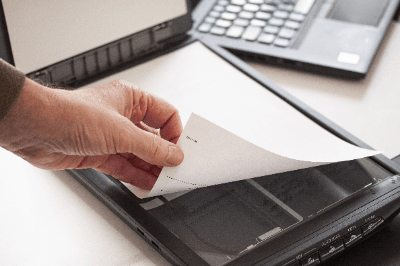What Is an Image Scanner?
 An Image Scanner is a device that converts images and text printed on paper or other physical media into electronic data.
An Image Scanner is a device that converts images and text printed on paper or other physical media into electronic data.
Image Scanners include the common flatbed scanner and document scanners that can scan large numbers of documents at high speed.
Flatbed scanners scan paper by placing it on a flatbed, allowing for the scanning of documents, photos, and other fine details.
Document scanners scan large volumes of documents efficiently because they automatically feed the paper as it is scanned. Image scanners convert paper documents into digital data that can be easily stored and shared as electronic files.
Some are also equipped with OCR (Optical Character Reader) functionality, allowing scanned documents to be converted into text data. Image scanners are widely used in the business world as a tool for efficient document management and document creation.
Uses of Image Scanners
Image Scanners are used to convert images and text printed on paper or other physical media into electronic data. Image Scanners are useful in business settings to improve document management and document creation efficiency.
For example, they are used for the following applications:
1. Document Management
Image scanners are used to convert paper documents into electronic files for easy document storage and retrieval. Documents can also be saved in a portable PDF format so that they can be viewed on the go.
2. Document Creation
Handwritten memos and drawings can be scanned with an image scanner and converted to electronic data for editing and processing.
In addition, with an image scanner equipped with OCR function, scanned documents can be converted to text data, which can then be edited in applications such as Microsoft Word and Excel.
3. Digital Archiving
Image scanners can be used to create digital archives by converting family photos, letters, and old documents into electronic data. Paper documents and photos are also suitable for preservation as they may deteriorate over time.
Principle of Image Scanner
Image scanner principles can be broadly classified into two types based on the reading method: CIS and CCD.
In the past, the CCD method was the mainstream, but nowadays the CIS method is gradually being adopted.
1. CCD Method
The CCD (Charge Coupled Devices) method uses a CCD as an image sensor, which reflects and concentrates light using multiple mirrors before the reflected light arrives, and then reads and converts the focused light into data using several lenses. This method is characterized by its deep depth of field, which allows it to read documents with large surface irregularities or those that are far away from the glass surface.
This method is favored in specialized fields such as film scanning. While the resolution is high, the main unit is large and requires a main power supply, so it must be stationary.
2. CIS Method
The CIS (Contact Image Sensor) method uses RGB tri-color LEDs with controllable blinking as the light source to read the reflected light from the document through a small equal-size lens and convert it into data using an image sensor (CMOS sensor).
The CIS method is widely used in popular models because of its simple structure, easy miniaturization, and energy saving (it can be operated with only a USB connection).
The disadvantage, however, is that the scanner must be placed in close contact with the glass surface to be able to read the image properly.
Types of Image Scanners
There are various types of image scanners, depending on the scanning method. Depending on your application, you can choose from a wide range of products, including those that are inexpensive and capable of scanning at high speeds.
1. Flatbed Scanner
Flatbed scanners are the most basic type of scanner and scan paper one sheet at a time. Because of their simple construction, flatbed scanners are inexpensive and readily available at affordable prices.
The advantage is that there is a low risk of soiling or folding the paper when scanning. However, since each sheet must be set up individually, scanning takes longer.
2. ADF Scanner
ADF scanners can scan large numbers of documents. These scanners have the ability to feed documents automatically, so when multiple documents are placed in the tray, the paper is fed in order and scanning is completed automatically.
This product is useful for scanning large quantities of documents, but care should be taken to avoid paper jams that can cause paper to break or snap.
3. Handheld Scanner
Handheld scanners, which can be hand-held for scanning, are becoming mainstream these days. They are useful for scanning books and other items that cannot be cut to size, or for scanning a portion of a large document such as a newspaper, but they are more time-consuming to scan than other types of products.
4. Overhead Scanner
This type of scanner can scan books and other documents from above without cutting them into page units. Some scanners have a function to correct distortion in the center of the book when the book is opened.